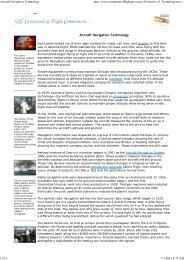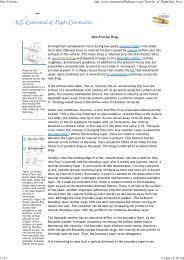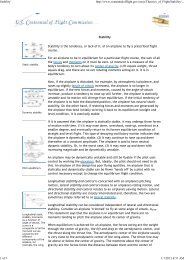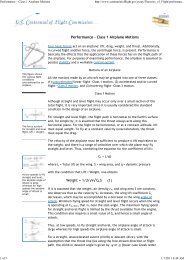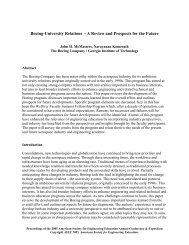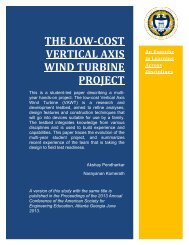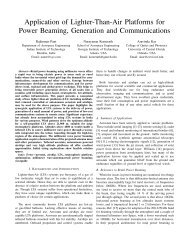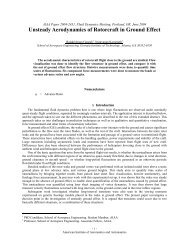Tip Vortex Formation and Evolution to the Near Wake of a Rotor in ...
Tip Vortex Formation and Evolution to the Near Wake of a Rotor in ...
Tip Vortex Formation and Evolution to the Near Wake of a Rotor in ...
Create successful ePaper yourself
Turn your PDF publications into a flip-book with our unique Google optimized e-Paper software.
core radius ( non-dim. by chord )0.150.10.0500 60 120 180 240 300 360 420 480 540vortex age ( degrees )Figure 10 - <strong>Evolution</strong> <strong>of</strong> <strong>the</strong> core radius on <strong>the</strong> ABSVI.5 Periodic Fluctuations <strong>in</strong> Core Axial VelocityThe evolution <strong>of</strong> <strong>the</strong> peak axial velocity is shown <strong>in</strong>Figure 13. The data from <strong>the</strong> front <strong>of</strong> <strong>the</strong> ro<strong>to</strong>r has beenremoved for clarity. On <strong>the</strong> ABS, <strong>the</strong> peak velocitystarts at a little over 20% <strong>of</strong> <strong>the</strong> tip-speed <strong>and</strong> rapidly<strong>in</strong>creases <strong>to</strong> nearly 60% <strong>of</strong> <strong>the</strong> tip-speed. This behavioris <strong>the</strong>n followed by a gradual decay back down <strong>to</strong> 20%<strong>of</strong> <strong>the</strong> tip-speed by a vortex age <strong>of</strong> 160°. The rear <strong>of</strong> <strong>the</strong>ro<strong>to</strong>r shows peak decay<strong>in</strong>g from 22% <strong>of</strong> <strong>the</strong> tip-speed <strong>to</strong>8% 108° <strong>of</strong> vortex age. On <strong>the</strong> RBS, <strong>the</strong> peak axialvelocity reaches nearly 80% <strong>of</strong> <strong>the</strong> tip-speed. A sharpdrop follows this peak <strong>to</strong> 23% <strong>of</strong> <strong>the</strong> tip-speed by 5° <strong>of</strong>vortex age. After that po<strong>in</strong>t, it exhibits harmonicoscillations. Inspection <strong>of</strong> <strong>the</strong> o<strong>the</strong>r velocities shows <strong>the</strong>same oscillations. The period <strong>of</strong> this oscillation is nearly10° <strong>of</strong> ro<strong>to</strong>r azimuth. This corresponds <strong>to</strong> a Strouhalnumber, based on blade tip thickness, <strong>of</strong> 0.16.0.00RBSABS-0.05-0.10z/R-0.15-0.20-0.25-0.30Rear view-0.35-0.40-1 -0.5 0 0.5 1y/RFigure 11 – <strong>Wake</strong> boundaries on <strong>the</strong> ABS <strong>and</strong> RBS0.04rear0-0.04z/R-0.08-0.12-0.16frontView from <strong>the</strong> RBS-1 -0.5 0 0.5 1x/RFigure 12 – <strong>Wake</strong> boundaries on <strong>the</strong> front <strong>and</strong> rearVa /(! R)0.80.60.40.2Strouhal No. = 0.16ABSRBSRear00 48 96 144vortex age ( degrees )Figure 13 - <strong>Evolution</strong> <strong>of</strong> <strong>the</strong> peak axial velocity (frontstation removed for clarity)Ano<strong>the</strong>r <strong>in</strong>terest<strong>in</strong>g feature <strong>of</strong> Figure 13 is <strong>the</strong> axialvelocity on <strong>the</strong> RBS reach<strong>in</strong>g nearly 80% <strong>of</strong> <strong>the</strong> tipspeed.The magnitude <strong>of</strong> this velocity alludes <strong>to</strong> <strong>the</strong>peak axial velocity reach<strong>in</strong>g tip-speed dur<strong>in</strong>g formationperhaps due <strong>to</strong> <strong>the</strong> no-slip boundary condition. Seedparticle dynamics may expla<strong>in</strong> why velocities <strong>of</strong> thismagnitude are not observed at <strong>the</strong> o<strong>the</strong>r stations. On <strong>the</strong>RBS <strong>the</strong> blade <strong>and</strong> freestream directions are <strong>the</strong> same.Therefore <strong>the</strong> velocity difference between seed particles<strong>in</strong> <strong>the</strong> freestream <strong>and</strong> <strong>the</strong> local fluid velocity around <strong>the</strong>blade is much smaller than at <strong>the</strong> o<strong>the</strong>r stations. As aresult, <strong>the</strong> seed particles can more quickly adjust <strong>to</strong> <strong>the</strong>local fluid velocity. Measurements were made <strong>to</strong> extend<strong>the</strong> data on <strong>the</strong> evolution <strong>of</strong> <strong>the</strong> axial velocity out <strong>to</strong>vortex age <strong>of</strong> 540°. By a vortex age <strong>of</strong> 160° <strong>the</strong> number<strong>of</strong> data po<strong>in</strong>ts <strong>in</strong>side <strong>the</strong> vortex core had dim<strong>in</strong>ished <strong>to</strong><strong>the</strong> po<strong>in</strong>t that no conclusion could be made on <strong>the</strong> peakaxial velocity.Copyright © American Helicopter Society. Presented at <strong>the</strong> 57 th AHS Forum, June 2001



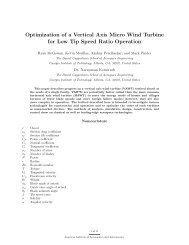
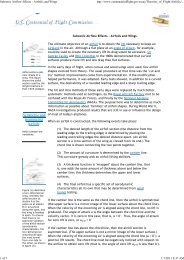

![p density of fluid, kg/m3 [Greek letter rho] V mean velocity of fluid, m ...](https://img.yumpu.com/50595898/1/184x260/p-density-of-fluid-kg-m3-greek-letter-rho-v-mean-velocity-of-fluid-m-.jpg?quality=85)
